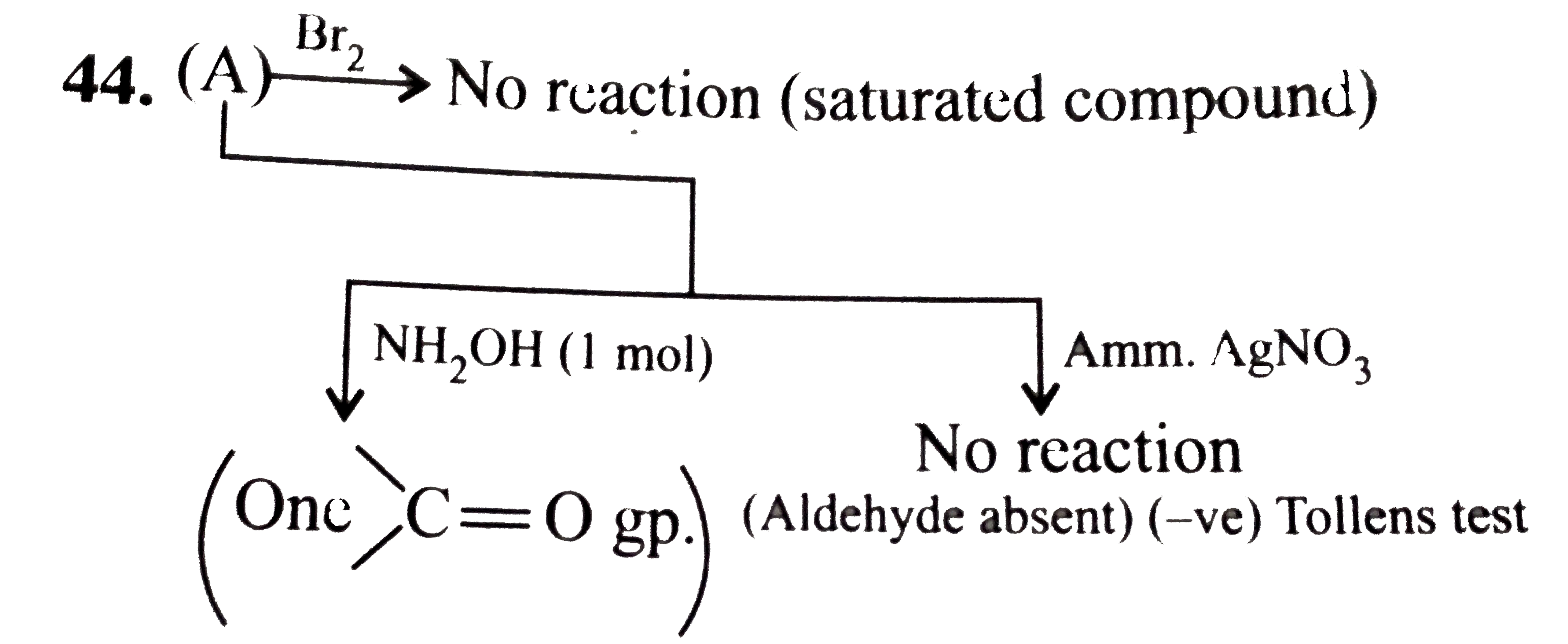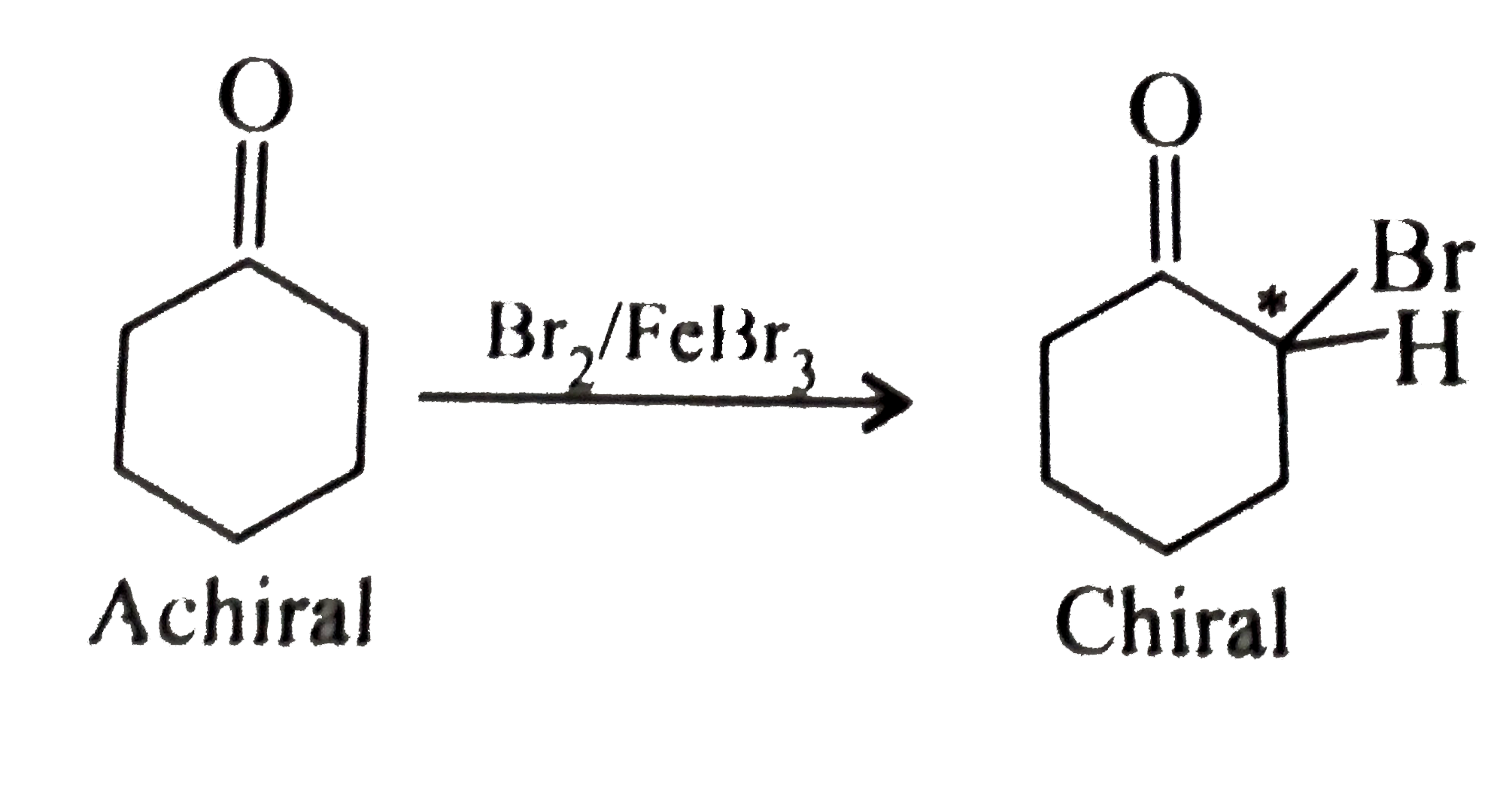An organic compound (A) contaning C, H, and O (16.32%) does not decolourise bromine water and does not give any precipitate with ammonical AgNO3. It consumes 1 mol of NH2OH per mole of (A) to give a solid derivative. The monobromo derivative of (A) shows optical activity. If (A) is optically inactive, suggest the structure.

(A) can be ketone of the type R−O∣∣C−R'. Percentage of O=16.32
Let R+R''=x, Mw of ketone =x+12+16=x+28(x+28) gm of ketone contains ⇒16x+28×100 gm of O
⇒16×100(x+28)=16.32⟨.x=70)
CnH2n+1=70⇒12n+2n+1=70
n=6914≈4.9
R and R' cannot be straight chain. There is possibility of ring structure with (−CO−) group. So (A) can be:

Topper's Solved these Questions
- ALIPHATIC AND AROMATIC ALDEHYDES AND KETONESBook:CENGAGE CHEMISTRYChapter:ALIPHATIC AND AROMATIC ALDEHYDES AND KETONESExercise:Exercises Concept Application
Explore 20 Videos
- ALIPHATIC AND AROMATIC ALDEHYDES AND KETONESBook:CENGAGE CHEMISTRYChapter:ALIPHATIC AND AROMATIC ALDEHYDES AND KETONESExercise:Exercises Linked Comprehension
Explore 59 Videos
- ALIPHATIC AND AROMATIC ALDEHYDES AND KETONESBook:CENGAGE CHEMISTRYChapter:ALIPHATIC AND AROMATIC ALDEHYDES AND KETONESExercise:Solved Examples
Explore 13 Videos
- ALCOHOL,PHENOL AND ETHERSBook:CENGAGE CHEMISTRYChapter:ALCOHOL,PHENOL AND ETHERSExercise:Archives Analytical And Descriptive
Explore 15 Videos
- AMINESBook:CENGAGE CHEMISTRYChapter:AMINESExercise:QUESTION BANK
Explore 1 Video
Similar Questions
A hydrocarbon X with molecular fomula C4H6 decolorizes bromine water and forms a white precipitate in ethanolic AgNO3 solution. Treatment of X with HgCl2 in aqueous H2SO4 produces a compounds, which gives a yellow precipitate when treated with I2 and NaOH. The structure of X is :
View SolutionCompound (A), C8H6NOBr, is optically active. Reduction of (A) gives (B) which reacts with nitrouos acid to form (C), dihydric alcohol. Benzene sulphonyl chloride reacts with (B) to give a product soluble in NaOH. Hydrolysis of (A) gives (D) which is an optically active acid. (A) does not give any precipitate with aqueous AgNO3 . Controlled oxidation of (A) gives monobromo benzoic acid. Compound (A) on reaction with Br2/Fe gives only one compound. Identify (A), (B), (C), and (D).
View Solution
Knowledge Check
An organic compound C3H6O does not give a precipitate with 2,4-dinitrophenyl hydrazine reagent and does not react with metallic sodium. It could be
ACH3CH2CHOBCH3COCH3CCH2=CH−CH2−OHDCH2=CH−O−CH3An organic compound C3H6O does not give a precipitate with 2,4-Dintirophenyl hydrazine reagent-
ACH3CH2CHOBCH3COCH3CCH2=CH−CH2OHD_E01_620_O04.png)
which of the following does not give a precipitate with 2,4-dinitrophenyl hydrazine and does not react with metallic sodium. It could be
ACH3−CH2−CHOBCH3−CO−CH3CCH2=CH−CH2OHDCH2=CH−O−CH3
An organic compound (A) C5H9Br which readily decolourises bromine water and KMnO4 solution gives (B), C5H11Br on treatment with Sn/HCI. The reaction of (A) with NaNH2 produces (C) with evolution of ammonia (C) neither reacts with sodium nor forms any metal acetylide but reacts with Lindlar catalyst to give (D) and on reaction with Na/liq.NH3 produces (E) .Both the compounds (D) and (E) are isomeric. Give structures of (A) to (E) with proper reasoning.
View SolutionThere are six isomeric alkenes (A, B, C, D, E, and F) that require 1 mol of H2 per mole of alkene for hydrogenation and give the same product (G) on hydrogenation. G is an alkane having the lowest molecular mass and is optically active. Write the structure of compounds from A to G.
View SolutionAn organic compound, (A) containing C, H, N and O, on analysis gives 49.32% carbon, 9.59% hydrogen and 19.18% nitrogen. (A) on boiling with NaOH gives off NH3 and a salt which on acidification gives a monobasic nitrogen -free acid (B). The silver salt of (B) contains 59.67% silver. Deduce the structures of (A) and (B)
View SolutionAn optically active alcohol A (C6H10O) absorbs 2 mol of hydrogen per mole of A upon catalytic hydrogenation and gives a product B. The compound B is resistant to oxidation by CrO3 and does not show any optical activity Deduce the structures of A and B.
View SolutionThere are five isomeric alkenes (A, B, C, D, and E) that require 1 mol of H2 per mole of alkene for hydrogenation and give the same product (F) on hydrogenation. F is an alkane having the lowest molecular mass and is opticalar mass and is optically active. Write the structures of the compounds from A to F.
View Solution

